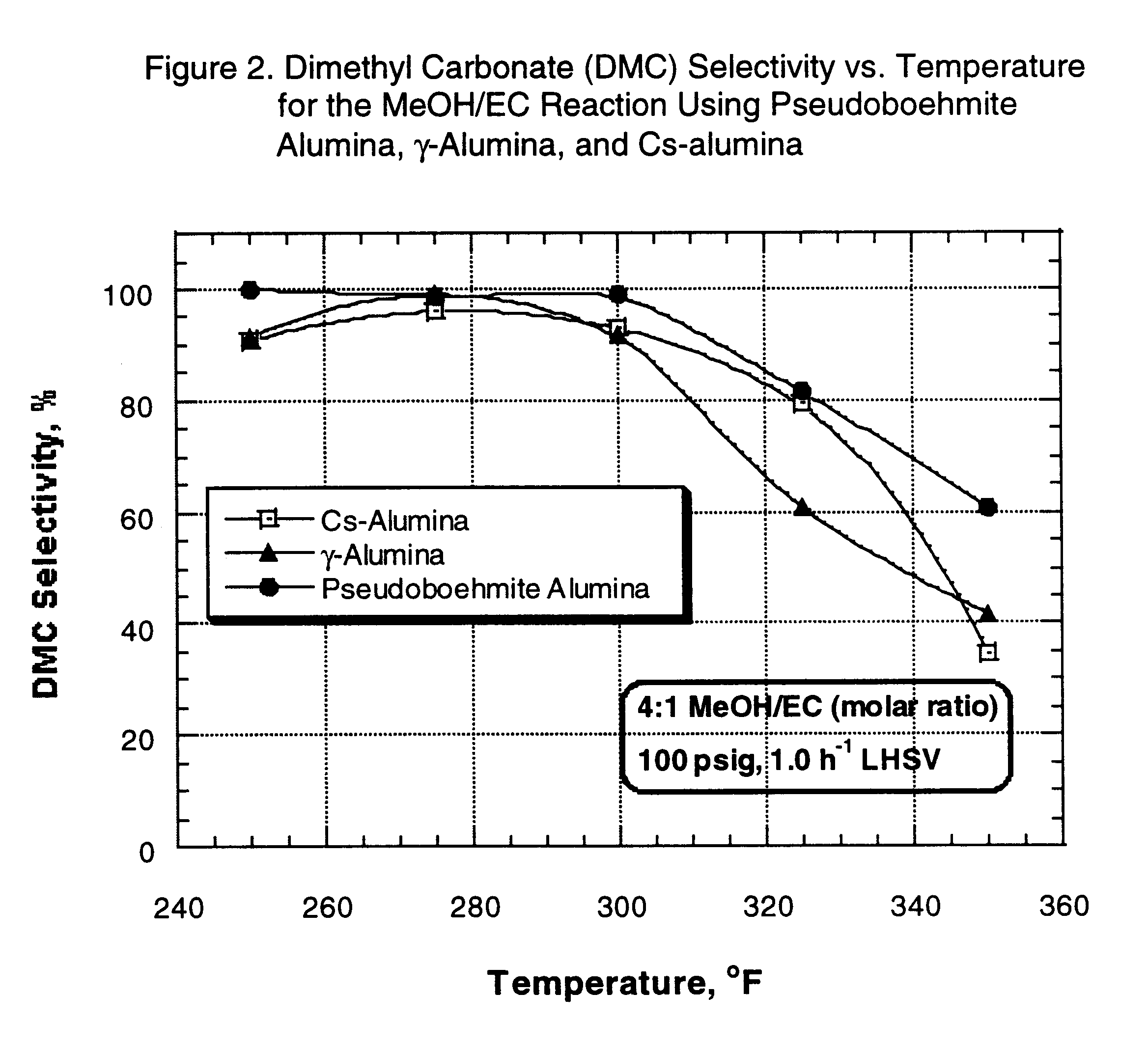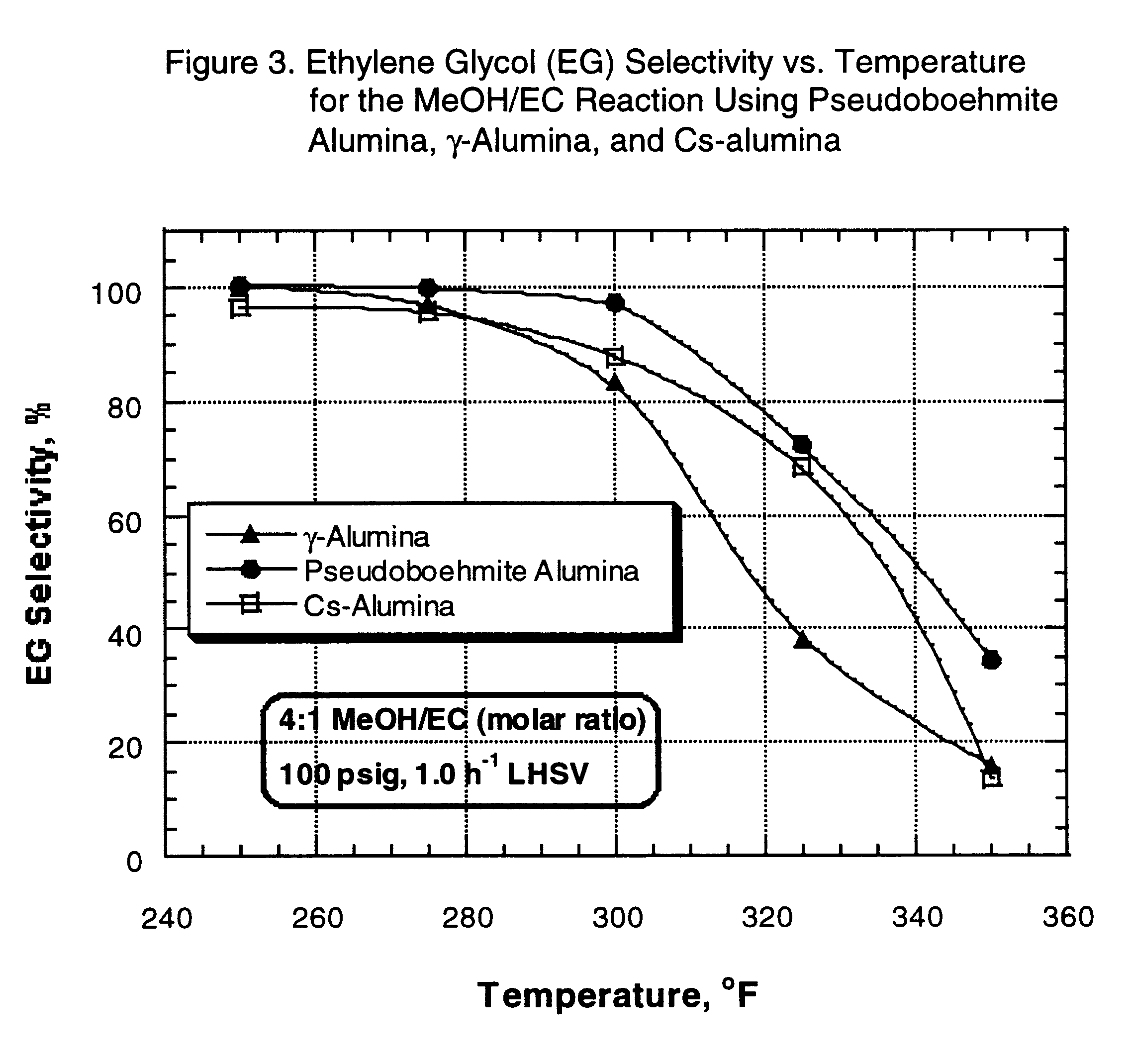Process for co-production of dialkyl carbonate and alkanediol
a dialkyl carbonate and alkanediol technology, which is applied in the preparation of oxygen-containing compounds, organic chemistry, chemistry apparatus and processes, etc., can solve the problems of reducing efficiency, limiting the commercial use of homogenous catalysts, and reducing the efficiency of catalysts
- Summary
- Abstract
- Description
- Claims
- Application Information
AI Technical Summary
Benefits of technology
Problems solved by technology
Method used
Image
Examples
example 1
This example describes a method for preparing three catalysts employed in the examples.
Three catalysts employed were: pseudoboehmite (fine particle boehmite) alumina, .gamma.-alumina (prepared from the pseudoboehmite alumina via calcination at 538.degree. C.), and Cs-containing alumina. Boehmite is a form of alumina with molecular formula (AlO--OH).sub.n. The physical properties of the three alumina samples are shown in Table 1.
TABLE 1 BET Surface H Content.sub.a Catalyst Area (m.sup.2 / g) (millimole / g) OH, wt %.sub.b Pseudoboehmite 356 3.7 6.3 alumina .gamma.-alumina 263 1.8 3.1 Cs-alumina 101 1.2 2.0 .sub.a H content determined by proton MAS NMR after samples were dried at 100.degree. C. for 12 hours under vacuum. See Example 2 for details. .sub.b OH wt % calculated from H content.
The pseudoboehmite alumina, a commercial sample, was pelleted and sized to 80-120 mesh prior to catalyst evaluation.
The .gamma.-alumina was prepared by mulling the commercial pseudoboehmite alumina powde...
example 2
This example describes the NMR characterization of the structures and H content of three alumina catalysts; pseudoboehmite, .gamma.-alumina, and Cs-alumina.
500.13 MHZ proton MAS NMR spectra were obtained on a Bruker AMX spectrometer using 12-15 kHz sample spinning, 2.7 .mu.s pulses, and a 30s recycle time. Chemical shifts are referenced to external TMS at 0.0 ppm. The samples were prepared for proton NMR experiments by drying at 100.degree. C. (to remove physisorbed water) under vacuum for 12 hours. An 83.8 / 16.2 mixture of D.sub.2 O (99% deuterated) and H.sub.2 O was used as the absolute .sup.1 H quantitation standard. The results are summarized in Table 1.
130.33 MHZ .sup.27 Al MAS NMR spectra were obtained on a 500 MHZ Bruker AMX spectrometer using 4.0-4.5 kHz sample spinning, 0.8 .mu.s excitation pulses, an 80 ms recycle time, and high power proton decoupling. 1M Al(NO.sub.3).sub.3 was the external chemical shift reference.
The pseudoboehmite catalyst is an alumina hydrate containi...
example 3
Transesterification evaluations were performed using each of the catalysts described in Example 1.
The transesterification evaluations were performed in a fixed bed microunit equipped with a three-zone furnace and a down-flow trickle-bed tubular reactor (1 / 2" ID). Catalyst powder was pelletized and sized to 80-120 mesh, and the reactor was loaded with 10 cc of the sized catalyst.
After pressure testing of the unit, the catalyst was dried at 400 .degree. F. for two hours under 1 atmosphere, 170 cc / min nitrogen flow. At the end of this period, the reactor was cooled down to 150.degree. F. (66.degree. C.) and nitrogen flow was stopped. The reactor pressure, controlled by a pressure regulator, was then set to 100 psi, and the EC / methanol mixture feed was pumped and added to the top of the reactor at 1.0 h.sup.-1 LHSV. The reactor temperature was gradually increased to initial operating temperature (250.degree. F.) (121.degree. C). Each material balance was typically started after the reac...
PUM
| Property | Measurement | Unit |
|---|---|---|
| Time | aaaaa | aaaaa |
| Pressure | aaaaa | aaaaa |
| Angle | aaaaa | aaaaa |
Abstract
Description
Claims
Application Information
 Login to View More
Login to View More - R&D
- Intellectual Property
- Life Sciences
- Materials
- Tech Scout
- Unparalleled Data Quality
- Higher Quality Content
- 60% Fewer Hallucinations
Browse by: Latest US Patents, China's latest patents, Technical Efficacy Thesaurus, Application Domain, Technology Topic, Popular Technical Reports.
© 2025 PatSnap. All rights reserved.Legal|Privacy policy|Modern Slavery Act Transparency Statement|Sitemap|About US| Contact US: help@patsnap.com



